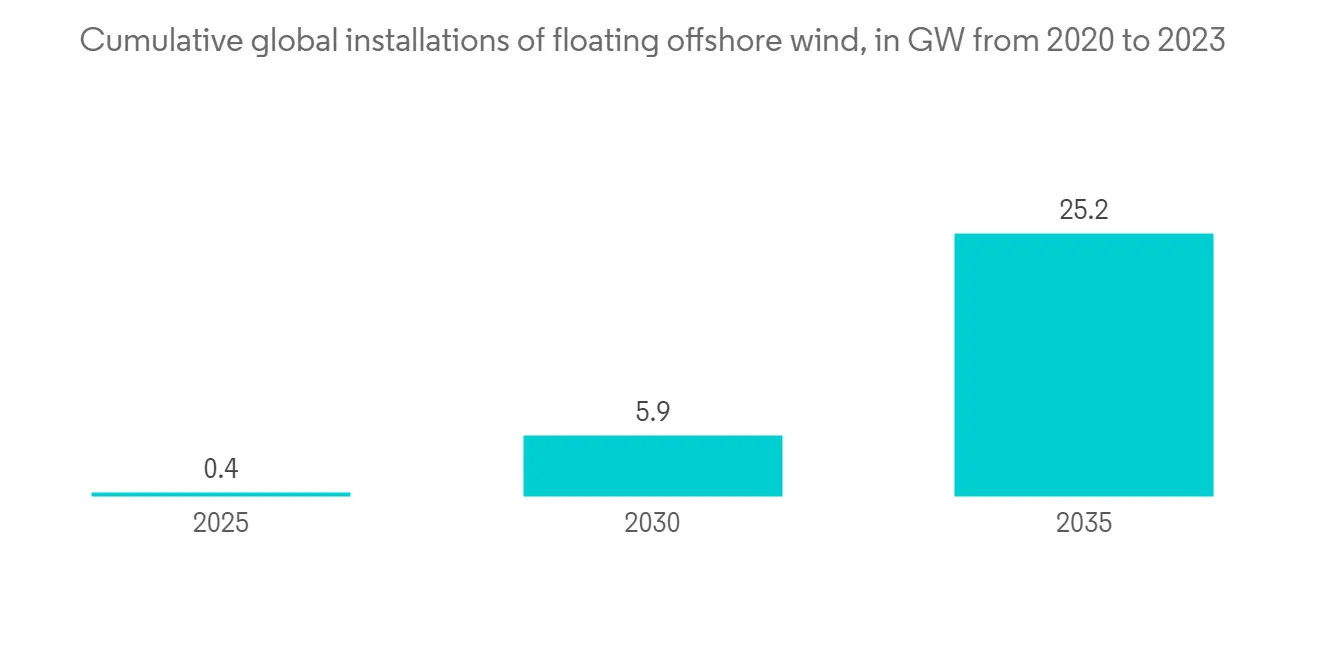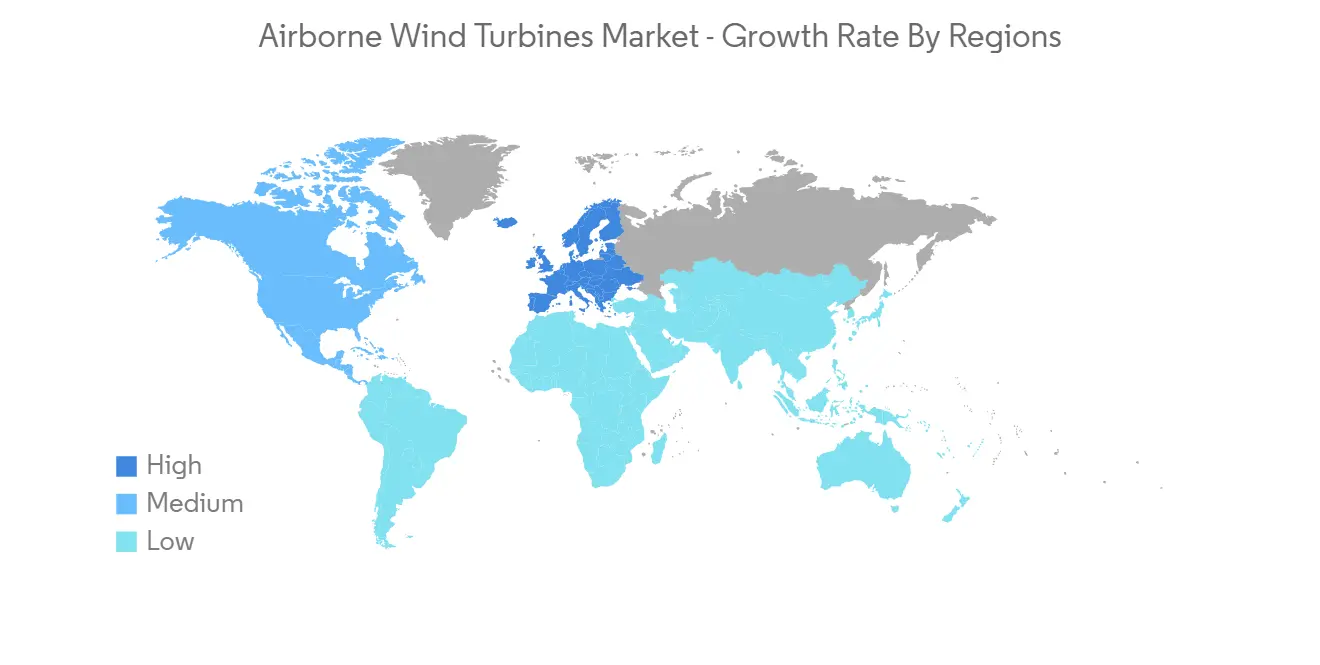PUBLISHER: Mordor Intelligence | PRODUCT CODE: 1331319

PUBLISHER: Mordor Intelligence | PRODUCT CODE: 1331319
Airborne Wind Turbines Market Size & Share Analysis - Growth Trends & Forecasts (2023 - 2028)
The Airborne Wind Turbines Market size is expected to grow from USD 129.81 million in 2023 to USD 200.56 million by 2028, at a CAGR of 9.09% during the forecast period (2023-2028).
With the huge potential and demand in the global wind turbine market, companies must invest in new technologies and introduce products that effectively use this green technology. Both military and disaster relief missions, which require quick and dependable electricity to function, might be powered by wind energy shortly.
Continuous inspection is necessary to spot damage and anomalies in wind turbines. Deposits on rotor blades require periodic cleaning, as damage to a turbine reduces its capacity to generate power and raises its noise output. Periodic inspection by technicians is a must to detect these damages. Automated methods are being created to continuously check the health of wind turbines to lower the cost of maintaining them and to help identify deviations from the norm as soon as feasible.
Toshiba launched its commercialized robot inspection services for power plant turbine generators. These robots are designed exclusively for thermal and nuclear power plant business maintenance services. The versatile robot also has a probe that uses ultrasound to check for interior flaws on the wedge and teeth of a turbine rotor.
The uncertainties, such as the COVID-19 pandemic and Russia-Ukraine, drastically affected energy demand and consumption. Despite these challenges, power generation technology showed its resilience to crises. Major sectors realized the cost-effective nature of renewable energy. ENGIE Laborelec participated in the Aquilon project at a Storengy gas storage facility in Germany to decarbonize its operations. The project used the SkySails airborne wind energy (AWE) solution, which harvestsed wind energy at greater altitudes than wind turbines by using a giant kite.
There is uncertainty over the technical resource potential of wind energy for AWE systems, as this will rely on the energy-harvesting capabilities of commercial designs, which can prevent clients from making quick investments in Airborne Wind turbines. AWE technologies are fundamentally new and require significant further development before being deployed at meaningful scales at the national level.
Airborne Wind Turbines Market Trends
Offshore Application to Have Substantial Growth in the Airborne Wind Turbines Market
Increasing offshore wind power is an opportunity to reduce dependence on fossil fuels and accelerate the journey to net zero. The potential of offshore energy can be understood with the stated example. One GE Haliade-X 12MW offshore wind turbine rotation produces enough energy to power the average UK home for 24 hours.
Offshore wind farms are making headlines worldwide for their scale as countries increasingly turn to them to reduce dependence on fossil fuels and accelerate the energy transition.
According to a report by Wood McKenzie, the Global capacity of large-scale wind farms is expected to increase from 34 GW in 2020 to 330 GW in 2030. The US Biden administration aims to reduce the cost of floating technologies up to 70% by 2035 and increase capacity to 15 GW by 2035, enough to power 5 million homes.
Danish energy company Orsted developed the world's largest fixed-bottom offshore wind farm off the coast of Yorkshire in the UK, called Hornsea 2, with 165 wind turbines sited next to its older sibling Hornsea 1. Together these farms can power 2.5 million homes, contributing to the UK government's goal of 50 GW in offshore wind capacity by 2030.
As of October 2022, only around 50 floating offshore wind turbines have been commissioned, and global stock is expected to exceed 5 GW by 2030 and 25 GW by 2035.
Mammoet organized the Offshore Wind Innovators contest to identify the potential of product innovation of various companies working towards developing new solutions in the Airborne Wind Turbine Market. One of the competition's finalists, Skylifter, presented an aerial crane lifting 250 tons, which performs maintenance of machine components and blades over 2,000 kilometers.

Europe Dominates the Airborne Wind Turbines Market
Europe has 207 GW of onshore wind capacity, and the European Commission has the vision to increase it to 1,000 GW by 2050 as part of its net-zero vision. Developing more wind sites to cater to this demand will drive the growth of the Airborne Wind Turbines Market in the region.
AWE can provide energy at a lower cost than established wind technology. By the early 2030s, AWE could compete at an average price lower than established wind technology. By harvesting more wind resource potential up to 300-500 meters, AWE is viable in more locations that are not viable for established wind technology.
About 20 small companies, most located in Europe, are developing devices for AWE, and some hope to have commercially operational ground systems by 2025. In collaboration with Norwegian Offshore Wind Cluster and its members, Makani took an energy kite trial that flew over the sea at the Metcentre test site. In partnership with the Norwegian Offshore Wind Cluster and its members, Makani ran a trail of an energy kite flying over the sea at the Metcentre test site.

Airborne Wind Turbines Industry Overview
Airborne Wind Turbines Market is moderately competitive with some key players such as GE Power, Enercon GmbH, Nordex SE, Siemens AG, and others. These companies are investing in various applications to gain market share and expand the scope of their service offerings. Businesses have remained competitive in the market by utilizing joint ventures, mergers, and acquisitions.
In January 2023, TUV SUD, the German Audit and certification service provider, signed a deal with Ventus Group to provide services to a wind energy company in India. As part of the deal, the duo will assist energy companies in India with technologies for measuring, analyzing, and optimizing the performance of wind farms and wind turbines utilizing Wind Turbine Generators (WTG). The clients would get guidance on maximizing safety and production from their existing and future wind energy investments.
In October 2022, Siemens Gamesa signed a contract with Airborne to engineer and supply an automated system for manufacturing composite offshore wind turbine blades. The project's key focus will cover manufacturing wind turbine blades, hybrid processing, and automation.
In February 2022, UK start-up, Windswept adopted to Shell GameChanger program to demonstrate the viability of autonomous Kite Turbine operation. The project will evaluate the kite turbines' scaling potential and offshore deployment needs. The earlier used human-operated launching and landing operations will become safer and more dependable with the introduction of new performance data, control systems, and handling equipment.
Additional Benefits:
- The market estimate (ME) sheet in Excel format
- 3 months of analyst support
TABLE OF CONTENTS
1 INTRODUCTION
- 1.1 Study Deliverables
- 1.2 Study Assumptions
- 1.3 Scope of the Study
2 RESEARCH METHODOLOGY
3 EXECUTIVE SUMMARY
4 MARKET DYNAMICS
- 4.1 Market Overview
- 4.2 Introduction to Market Drivers and Restraints
- 4.3 Market Drivers
- 4.3.1 Ever-growing Consumption of Electricity in Emerging Economies
- 4.3.2 Low Maintenance of Wind Energy Technologies
- 4.4 Market Restraints
- 4.4.1 Cost of Building and Installing Turbines
- 4.5 Industry Attractiveness - Porter's Five Forces Analysis
- 4.5.1 Threat of New Entrants
- 4.5.2 Bargaining Power of Buyers/Consumers
- 4.5.3 Bargaining Power of Suppliers
- 4.5.4 Threat of Substitute Products
- 4.5.5 Intensity of Competitive Rivalry
5 MARKET SEGMENTATION
- 5.1 By Technology
- 5.1.1 Larger Turbines (above 3 MW)
- 5.1.2 Smaller Turbines (Less than 3 MW)
- 5.2 By Application
- 5.2.1 Offshore
- 5.2.2 Onshore
- 5.3 Geography
- 5.3.1 North America
- 5.3.1.1 United States
- 5.3.1.2 Canada
- 5.3.2 Europe
- 5.3.2.1 United Kingdom
- 5.3.2.2 Germany
- 5.3.2.3 France
- 5.3.2.4 Rest of the Europe
- 5.3.3 Asia Pacific
- 5.3.3.1 China
- 5.3.3.2 Japan
- 5.3.3.3 India
- 5.3.3.4 Rest of the Asia Pacific
- 5.3.4 Latin America
- 5.3.5 Middle East
- 5.3.1 North America
6 COMPETITIVE LANDSCAPE
- 6.1 Company Profiles
- 6.1.1 Vestas Wind Systems A/S
- 6.1.2 Nordex SE
- 6.1.3 Enercon GmbH
- 6.1.4 GE Power
- 6.1.5 Siemens AG
- 6.1.6 Senvion S.A.
- 6.1.7 Goldwind
- 6.1.8 United Power Inc
- 6.1.9 Envision Energy
- 6.1.10 Suzlon Energy Ltd.
7 INVESTMENT ANALYSIS
8 MARKET OPPORTUNITIES AND FUTURE TRENDS




